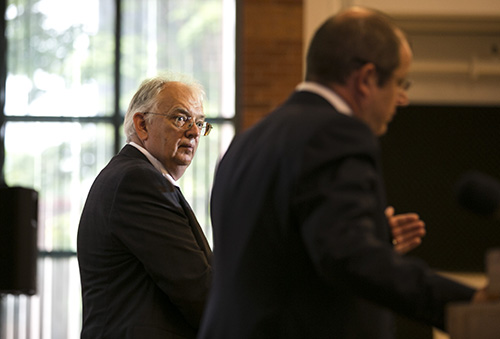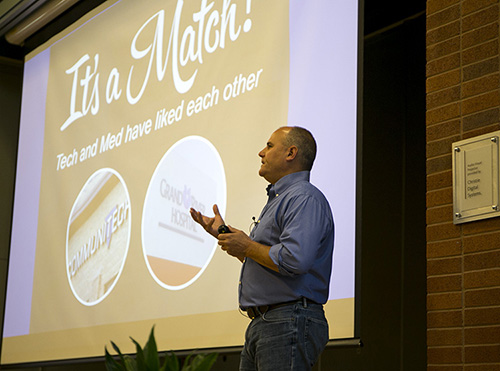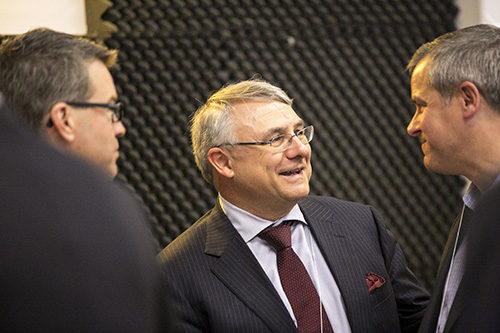Grand River Hospital Freeport Campus – a sprawling, beautiful complex that leaders in the region hope will become a major hub for medical innovation – hosted an unusual sort of crowd Wednesday: entrepreneurs from the Waterloo Region tech community.
They came for Waterloo Region Med Tech Bridging the Gap 2016, a conference designed to inspire collaborations between tech entrepreneurs and medical professionals, and hosted by Grand River Hospital, the University of Waterloo and Communitech.
The location was poignant: With the doors of the Sun Life Town Hall auditorium thrown open, attendees often saw patients wheeling by in chairs, limping past on crutches, or holding the hand of an attending nurse. Perhaps by design, the environment ensured the focus stayed squarely on the people who needed it most.
The term “med tech” evokes images of exotic, Star Trek technology: remote-controlled robots performing surgery, wound dressings that promote healing and skin cell guns.

Oculys Health Informatics Chief Scientist Ken McKay (left) and President and
CEO Franck Hivert (right) share their story of growth in Canada
(Communitech Photo: Phil Froklage).
So I was stunned when, by the lunch break, just one medical innovation had taken the lion’s share of the discussion: software for managing patient information. Entrepreneurs bragged that the hospitals they worked with no longer forgot about patients in their waiting rooms. My appetite for the future would have to wait: Ontario healthcare still needed help getting into the 21st century.
“There definitely is technology in the spaces that you’re talking about,” Dr. Catherine Burns, Director of the Centre for Bioengineering and Biotechnology at the University of Waterloo, told me when I begged for some futuristic tech.
“What you’re seeing here is an evolution path; all of that stuff is still in the labs, and what you’re seeing here today are the technologies that are most relevant from a hospital and a patient-flow perspective. They’re the first things being adopted, but I’m hoping we can see some of those things at the med tech conference maybe 10 years from now, because it’s happening and we do have people at (the University of) Waterloo who are working on that.”
Getting this technology out of the lab and into hospitals means confronting a problem that plagues all Canadian entrepreneurs: the lack of risk capital in our country.
“The first thing someone said to me was ‘get two or three hospitals and head south. Get out of Ontario. Get out of Canada, actually,” said Franck Hivert, President and CEO of Oculys Health Informatics, responding to a question about the difficulty of the Ontario climate for medical entrepreneurs. Oculys develops software that makes real-time data useful to healthcare professionals. It’s able to predict wait times in the emergency room, show doctors how many patients are waiting and what stage the patient is at in their visit, as well as aggregate data about how patients are flowing through the facility, and so on.
Advisors were suggesting to Hivert that healthcare is too risky for Canadian investors. Hivert ignored them, and Oculys software is now running in 25 hospitals across Ontario and Manitoba with mouthwatering growth statistics to match.
Why did Hivert ignore the advice and take a chance on the Canadian market?
Because Ontario is, as he put it, an “innovation sandbox.”
“I truly believe that there is enough brain power here, there’s enough innovation here, there just needs to be a bit more desire for taking a risk to do something spectacular.”
Communitech CEO Iain Klugman shared his perspective on the problem, having just returned from a growing tech ecosystem that shares Ontario’s opportunity and ambition: Israel. Along with great restaurants, nightlife and a culture that attracts ambitious young people, Israel’s key differentiator from Ontario is capital

Communitech CEO Iain Klugman tells the gathered crowd at
Waterloo Region Med Tech Bridging the Gap 2016 about the challenges facing
Canadian entrepreneurs on the global stage (Communitech Photo: Phil Froklage).
“They’ve got between four and five times the amount of venture capital. It became really obvious that, while so many of our universities are similar, so many of our companies are similar, so much of the rate of startup activity et cetera is similar, the one thing that is not is that they’re overfunding their companies and it’s making stuff happen. They’re seeing the exits, they’re seeing the acquisitions, they’re seeing the IPOs and they’re seeing the growth.”
Diagnosing the problem is a tall order, and Klugman says it’s caused by a host of factors that are tough to pin down: things like history, national character and timing. But he insisted it has nothing to do with money.
“We are a very wealthy nation, we’ve got lots and lots of money, but people kind of sit on it and pile it into real estate… There’s definitely enough money in Canada. There’s not enough risk money.”
This problem is top-of-mind for William Charnetski, the Ministry of Health's chief innovation strategist who oversees a $20-million fund designed to foster innovation in the healthcare system. Charnetski said that risk aversion “comes out over and over again” as he tours the province, getting the lay of the land in health innovation.
The Ontario government is “cash-strapped,” he said, making risky bets almost impossible.
“If you’re really nervous about the money, it’s really hard to make the decision to go with the company that’s been around for 18 months, if, roughly, the comparable comes from a company that’s been around for 70 years and you’ve worked with them for the last 15. I get that. That’s just people being people.”
Even more than the money problem, Charnetski insisted the issue is systemic. He gave an example that he said “gets right to the core of risk tolerance or the lack thereof” – a procedural rule about hospital procurement.
If a hospital wants to bring in a new piece of technology from an outside bidder, the hospital board – staffed entirely by volunteers – must personally sign a paper that says the technology coming in adheres to all the rules and regulations it’s supposed to. They absorb the risk individually. Charnetski pointed out that this is unique to medical technology; these rules don't apply to the board of Hydro One, for instance.
The rule itself is hostile to innovation.
“. . . There’s no reward for my risk. So I’m asking the lawyer from, probably, a big downtown law firm in whatever city you’re in, and they’re going to give you a conservative view, and you’re going to go even more conservative because you’ve got to sign the thing, and we’re really going to try to change that.”
Charnetski repeated that the problem wasn’t bad people doing bad things, but systemic challenges arising from how the rules are written.
“Every process is designed perfectly to produce what it produces. Right? So, if you were to actually. . .sit in a working group and say ‘let’s draw up a system that blocks innovation,’ you’d be hard-pressed to do a better one than the one we have.

Bridging the Gap conference organizer Dr. Doug Dittmer (centre) greets
BlackBerry Sr. VP and Chief Evangelist Mark Wilson (Communitech Photo: Phil Froklage).
Dr. Doug Dittmer, the organizer and driving force behind Bridging the Gap, hopes to change that. Agreeing with Charnetski that the systems in place are key to innovation, he hopes to create a new one that favours entrepreneurship in med tech: an innovation hub at Grand River Hospital Freeport Campus.
“I was going to medical conferences in Victoria and Halifax, and I would ask them, ‘What are you guys doing in IT?’ They looked at me and said, ‘You're from Kitchener-Waterloo, why aren’t you telling us?’ It dawned on us that the place that this should happen is right here… We have all the elements here. It's just a matter of bringing them together.”

